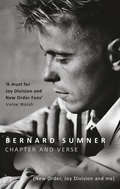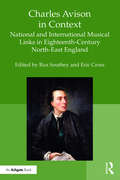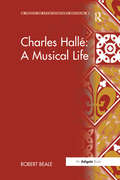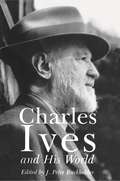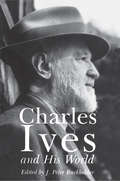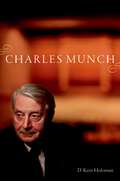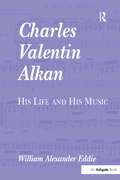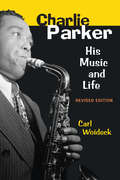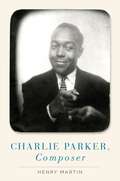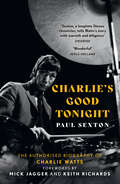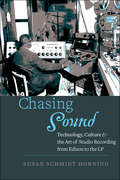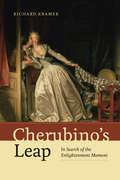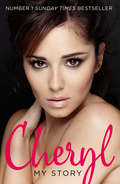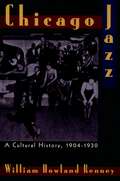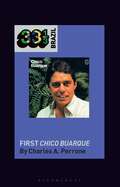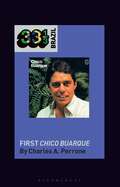- Table View
- List View
Chapter and Verse - New Order, Joy Division and Me: New Order, Joy Division And Me
by Bernard SumnerFounding member and guitarist of Joy Division and the lead singer of New Order, Bernard Sumner has been famous over the years for his reticence. Until now… An integral part of the Manchester music scene since the late 1970s, his is the definitive version of the events that created two of the most influential bands of all time. Chapter and Verse includes a vivid and illuminating account of Bernard’s Salford childhood, the early days of Joy Division, the band’s enormous critical and popular success, and the subsequent tragic death of Ian Curtis. Bernard describes the formation of New Order, takes us behind the scenes at the birth of classics such as 'Blue Monday' and gives his first-hand account of the ecstasy and the agony of the Haçienda days.Sometimes moving, often hilarious and occasionally completely out of control, this is a tale populated by some of the most colourful and creative characters in music history, such as Ian Curtis, Tony Wilson, Rob Gretton and Martin Hannett. Others have told parts of the story, in film and book form. Now, for the first time, Bernard Sumner gives you chapter and verse.
Charles Avison in Context: National and International Musical Links in Eighteenth-Century North-East England
by Roz Southey Eric CrossDespite recent interest in music-making in the so-called ’provinces’, the idea still lingers that music-making outside London was small in scale, second-rate and behind the times. However, in Newcastle upon Tyne, the presence of a nationally known musician, Charles Avison (1709-1770), prompts a reassessment of how far this idea is still tenable. Avison’s life and work illuminates many wider trends. His relationships with his patrons, the commercial imperatives which shaped his activities, the historical and social milieu in which he lived and worked, were influenced by and reflected many contemporary movements: Latitudinarianism, Methodism, the improvement of church music, the aesthetics of the day including new ideas circulating in Europe, discussions of issues such as gentility, and the new commercialism of leisure. He can be considered as the notional centre of a web of connections, both musical and non-musical, extending through every part of Britain and into both Europe and America. This book looks at these connections, exploring the ways in which the musical culture in the north-east region interacted with, and influenced, musical culture elsewhere, and the non-musical influences with which it was involved, including contemporary religious, philosophical and commercial developments, establishing that regional centres such as Newcastle could be as well-informed, influential and vibrant as London.
Charles Avison in Context: National and International Musical Links in Eighteenth-Century North-East England
by Roz Southey Eric CrossDespite recent interest in music-making in the so-called ’provinces’, the idea still lingers that music-making outside London was small in scale, second-rate and behind the times. However, in Newcastle upon Tyne, the presence of a nationally known musician, Charles Avison (1709-1770), prompts a reassessment of how far this idea is still tenable. Avison’s life and work illuminates many wider trends. His relationships with his patrons, the commercial imperatives which shaped his activities, the historical and social milieu in which he lived and worked, were influenced by and reflected many contemporary movements: Latitudinarianism, Methodism, the improvement of church music, the aesthetics of the day including new ideas circulating in Europe, discussions of issues such as gentility, and the new commercialism of leisure. He can be considered as the notional centre of a web of connections, both musical and non-musical, extending through every part of Britain and into both Europe and America. This book looks at these connections, exploring the ways in which the musical culture in the north-east region interacted with, and influenced, musical culture elsewhere, and the non-musical influences with which it was involved, including contemporary religious, philosophical and commercial developments, establishing that regional centres such as Newcastle could be as well-informed, influential and vibrant as London.
Charles Hallé: A Musical Life
by Robert BealeCharles Hall as one of the leading musicians of the nineteenth century and intimate with almost all of the great composers and performers of his time, as well as a friend of the Royal Family and known as much as a pianist and chamber musician as a conductor, in London, throughout the country and abroad, in addition to Manchester. Robert Beale presents a new perspective on Hall life and achievement, constructed mainly from primary sources, which serves to dispel many of the inaccuracies and omissions that have stemmed, to a great extent, from Hall own autobiographical account of 1896. His edited memoirs omit much of the competition and controversy, struggles and disappointments of his career in Manchester, and, indeed, hardly convey the scope of his activities elsewhere. Hall as a key figure in the shift from contemporary toclassical repertory in orchestral concerts and piano performance. Not only did he found the Manchester orchestra, in 1862-3 he also gave the first known cycle of Beethoven's piano sonatas. His early annualrecital series in London marked a new era in the musical history of his time. The formation of the modern 'symphony orchestra' took place during the period of Hall professional life, and he was a pioneer in the process, in both artistic and business terms. Having adopted the role of orchestral conductor when it was itself relatively novel, he became one of the acknowledged masters of the craft over four and half decades - as well as continuing to appear as solo pianist and chamber musician, and in addition he was enormously influential as musical pedagogue and educationist.
Charles Hallé: A Musical Life
by Robert BealeCharles Hall as one of the leading musicians of the nineteenth century and intimate with almost all of the great composers and performers of his time, as well as a friend of the Royal Family and known as much as a pianist and chamber musician as a conductor, in London, throughout the country and abroad, in addition to Manchester. Robert Beale presents a new perspective on Hall life and achievement, constructed mainly from primary sources, which serves to dispel many of the inaccuracies and omissions that have stemmed, to a great extent, from Hall own autobiographical account of 1896. His edited memoirs omit much of the competition and controversy, struggles and disappointments of his career in Manchester, and, indeed, hardly convey the scope of his activities elsewhere. Hall as a key figure in the shift from contemporary toclassical repertory in orchestral concerts and piano performance. Not only did he found the Manchester orchestra, in 1862-3 he also gave the first known cycle of Beethoven's piano sonatas. His early annualrecital series in London marked a new era in the musical history of his time. The formation of the modern 'symphony orchestra' took place during the period of Hall professional life, and he was a pioneer in the process, in both artistic and business terms. Having adopted the role of orchestral conductor when it was itself relatively novel, he became one of the acknowledged masters of the craft over four and half decades - as well as continuing to appear as solo pianist and chamber musician, and in addition he was enormously influential as musical pedagogue and educationist.
Charles Ives and His World: Charles Ives And The Uses Of Musical Borrowing (The Bard Music Festival #51)
by J. BurkholderThis volume shows Charles Ives in the context of his world in a number of revealing ways. Five new essays examine Ives's relationships to European music and to American music, politics, business, and landscape. J. Peter Burkholder shows Ives as a composer well versed in four distinctive musical traditions who blended them in his mature music. Leon Botstein explores the paradox of how, in the works of Ives and Mahler, musical modernism emerges from profoundly antimodern sensibilities. David Michael Hertz reveals unsuspected parallels between one of Ives's most famous pieces, the Concord Piano Sonata, and the piano sonatas of Liszt and Scriabin. Michael Broyles sheds new light on Ives's political orientation and on his career in the insurance business, and Mark Tucker shows the importance for Ives of his vacations in the Adirondacks and the representation of that landscape in his music. The remainder of the book presents documents that illuminate Ives's personal life. A selection of some sixty letters to and from Ives and his family, edited and annotated by Tom C. Owens, is the first substantial collection of Ives correspondence to be published. Two sections of reviews and longer profiles published during his lifetime highlight the important stages in the reception of Ives's music, from his early works through the premieres of his most important compositions to his elevation as an almost mythic figure with a reputation among some critics as America's greatest composer.
Charles Ives and His World (The Bard Music Festival: 7) (PDF)
by J. BurkholderThis volume shows Charles Ives in the context of his world in a number of revealing ways. Five new essays examine Ives's relationships to European music and to American music, politics, business, and landscape. J. Peter Burkholder shows Ives as a composer well versed in four distinctive musical traditions who blended them in his mature music. Leon Botstein explores the paradox of how, in the works of Ives and Mahler, musical modernism emerges from profoundly antimodern sensibilities. David Michael Hertz reveals unsuspected parallels between one of Ives's most famous pieces, the Concord Piano Sonata, and the piano sonatas of Liszt and Scriabin. Michael Broyles sheds new light on Ives's political orientation and on his career in the insurance business, and Mark Tucker shows the importance for Ives of his vacations in the Adirondacks and the representation of that landscape in his music. The remainder of the book presents documents that illuminate Ives's personal life. A selection of some sixty letters to and from Ives and his family, edited and annotated by Tom C. Owens, is the first substantial collection of Ives correspondence to be published. Two sections of reviews and longer profiles published during his lifetime highlight the important stages in the reception of Ives's music, from his early works through the premieres of his most important compositions to his elevation as an almost mythic figure with a reputation among some critics as America's greatest composer.
Charles Munch
by D. Kern HolomanA mesmerizing figure in concert, Charles Munch was celebrated for his electrifying public performances. He was a pioneer in many arenas of classical music--establishing Berlioz in the canon, perfecting the orchestral work of Debussy and Ravel, and leading the world to Roussel, Honegger, and Dutilleux. A pivotal figure, his accomplishments put him on a par with Arturo Toscanini and Leonard Bernstein. In Charles Munch, D. Kern Holoman provides the first full biography of this giant of twentieth-century music, tracing his dramatic survival in occupied Paris, his triumphant arrival at the Boston Symphony Orchestra, and his later years, when he was a leading cultural figure in the United States, a man known and admired by Presidents Truman, Eisenhower, and Kennedy. He turned to conducting only in middle age, after two decades as a violinist and concertmaster, a background which gave him special insight into the relationship between conductor and orchestra. At the podium, his bond with his musicians unleashed something in them and in himself. "A certain magic took wing that amounts to the very essence of music in concert," the author writes, as if "public performance loosed the facets of character and artistry and poetry otherwise muffled by his timidity and simple disinclination to say much." In concert, Munch was arresting, even seductive, sweeping his baton in an enormous arch from above his head down to his knee. Yet as Holoman shows, he remained a lonely, even sad figure, a widower with no children, a man who fled admirers and avoided reporters. With groundbreaking research and sensitive, lyrical writing, Charles Munch penetrates the enigma to capture this elusive musical titan.
Charles Munch
by D. Kern HolomanA mesmerizing figure in concert, Charles Munch was celebrated for his electrifying public performances. He was a pioneer in many arenas of classical music--establishing Berlioz in the canon, perfecting the orchestral work of Debussy and Ravel, and leading the world to Roussel, Honegger, and Dutilleux. A pivotal figure, his accomplishments put him on a par with Arturo Toscanini and Leonard Bernstein. In Charles Munch, D. Kern Holoman provides the first full biography of this giant of twentieth-century music, tracing his dramatic survival in occupied Paris, his triumphant arrival at the Boston Symphony Orchestra, and his later years, when he was a leading cultural figure in the United States, a man known and admired by Presidents Truman, Eisenhower, and Kennedy. He turned to conducting only in middle age, after two decades as a violinist and concertmaster, a background which gave him special insight into the relationship between conductor and orchestra. At the podium, his bond with his musicians unleashed something in them and in himself. "A certain magic took wing that amounts to the very essence of music in concert," the author writes, as if "public performance loosed the facets of character and artistry and poetry otherwise muffled by his timidity and simple disinclination to say much." In concert, Munch was arresting, even seductive, sweeping his baton in an enormous arch from above his head down to his knee. Yet as Holoman shows, he remained a lonely, even sad figure, a widower with no children, a man who fled admirers and avoided reporters. With groundbreaking research and sensitive, lyrical writing, Charles Munch penetrates the enigma to capture this elusive musical titan.
Charles Valentin Alkan: His Life and His Music
by WilliamAlexander EddieA 'conservative radical' is William Alexander Eddie's description of the French virtuoso composer-pianist Charles Valentin Alkan (1813-1888). Judaic culture, the French baroque and German classicism were the main influences on Alkan's musical style, with more radical musical tendencies found in many of the Esquisses op 63. This comprehensive survey takes as its focus a stylistic analysis of Alkan's compositions from the apprentice works to the later 'massed style' etudes; the latter are of considerable length and pianistic difficulty. There is also consideration of Alkan's achievements as pianist and teacher, and the sections on performance practice in Alkan will be of interest to pianists today. A full investigation of Alkan's reception history is also included and useful appendices provide a guide to further archival research. A list of works and basic discography complete this new study of an important French composer.
Charles Valentin Alkan: His Life and His Music
by WilliamAlexander EddieA 'conservative radical' is William Alexander Eddie's description of the French virtuoso composer-pianist Charles Valentin Alkan (1813-1888). Judaic culture, the French baroque and German classicism were the main influences on Alkan's musical style, with more radical musical tendencies found in many of the Esquisses op 63. This comprehensive survey takes as its focus a stylistic analysis of Alkan's compositions from the apprentice works to the later 'massed style' etudes; the latter are of considerable length and pianistic difficulty. There is also consideration of Alkan's achievements as pianist and teacher, and the sections on performance practice in Alkan will be of interest to pianists today. A full investigation of Alkan's reception history is also included and useful appendices provide a guide to further archival research. A list of works and basic discography complete this new study of an important French composer.
Charlie Parker: His Music and Life (The Michigan American Music Series)
by Carl WoideckSaxophonist Charlie Parker (1920-1955) was one of the most innovative and influential jazz musicians of any era. As one of the architects of modern jazz (often called "bebop"), Charlie Parker has had a profound effect on American music. His music reached such a high level of melodic, rhythmic, and harmonic sophistication that saxophonists and other instrumentalists continue to study it as both a technical challenge and an aesthetic inspiration. This revised edition of Charlie Parker: His Music and Life has been revised throughout to account for new Charlie Parker scholarship and previously unknown Parker recordings that have emerged since the book’s initial publication. The volume opens by considering current research on Parker’s biography, laying out some of the contradictory accounts of his life, and setting the chronology straight where possible. It then focuses on Parker’s music, tracing his artistic evolution and major achievements as a jazz improviser. The musical discussions and transcribed musical examples include timecodes for easy location in recordings—a unique feature to this book.
Charlie Parker, Composer
by Henry MartinAs a founding father of bebop and brilliant jazz improviser, Charlie Parker has secured a reputation and legacy second to none since his birth nearly 100 years ago. Because of his excellence as an improviser, however, his compositions - while admired and still played - have taken a back seat. In this exciting and timely new volume, author Henry Martin rebalances our understanding of Parker by spotlighting his significance as a jazz composer. Beginning with a review of Parker's life and musical training, Charlie Parker, Composer critically analyzes Parker's compositions, situating them within both his individual musicianship and early bebop style. Proposing that Parker composed up to 84 pieces, Martin examines their development and aesthetic qualities, their similarities and dissimilarities within a range of seven types of jazz composition. Also discussed are eight tunes credited to Parker but never performed by him, along with an evaluation of where - if at all - they fit in his oeuvre. Providing the first assessment of a major jazz composer's output in its entirety, Charlie Parker, Composer offers a thorough reexamination, through music-theoretical, historical, and philosophical lenses, of one of the most influential jazz musicians of all time.
Charlie Parker, Composer
by Henry MartinAs a founding father of bebop and brilliant jazz improviser, Charlie Parker has secured a reputation and legacy second to none since his birth nearly 100 years ago. Because of his excellence as an improviser, however, his compositions - while admired and still played - have taken a back seat. In this exciting and timely new volume, author Henry Martin rebalances our understanding of Parker by spotlighting his significance as a jazz composer. Beginning with a review of Parker's life and musical training, Charlie Parker, Composer critically analyzes Parker's compositions, situating them within both his individual musicianship and early bebop style. Proposing that Parker composed up to 84 pieces, Martin examines their development and aesthetic qualities, their similarities and dissimilarities within a range of seven types of jazz composition. Also discussed are eight tunes credited to Parker but never performed by him, along with an evaluation of where - if at all - they fit in his oeuvre. Providing the first assessment of a major jazz composer's output in its entirety, Charlie Parker, Composer offers a thorough reexamination, through music-theoretical, historical, and philosophical lenses, of one of the most influential jazz musicians of all time.
Charlie's Good Tonight: The Authorised Biography Of Charlie Watts
by Paul SextonFeaturing forewords from bandmates Mick Jagger and Keith Richards, this is the official and fully authorised biography of the world’s most revered and celebrated drummer.
Chasing Sound: Technology, Culture, and the Art of Studio Recording from Edison to the LP (Studies in Industry and Society)
by Susan Schmidt HorningIn Chasing Sound, Susan Schmidt Horning traces the cultural and technological evolution of recording studios in the United States from the first practical devices to the modern multi-track studios of the analog era. Charting the technical development of studio equipment, the professionalization of recording engineers, and the growing collaboration between artists and technicians, she shows how the earliest efforts to capture the sound of live performances eventually resulted in a trend toward studio creations that extended beyond live shows, ultimately reversing the historic relationship between live and recorded sound. Schmidt Horning draws from a wealth of original oral interviews with major labels and independent recording engineers, producers, arrangers, and musicians, as well as memoirs, technical journals, popular accounts, and sound recordings. Recording engineers and producers, she finds, influenced technological and musical change as they sought to improve the sound of records. By investigating the complex relationship between sound engineering and popular music, she reveals the increasing reliance on technological intervention in the creation as well as in the reception of music. The recording studio, she argues, is at the center of musical culture in the twentieth century.
The Cheat Sheet: TikTok made me buy it! The romcom hit of 2022!
by Sarah AdamsIs it ever too late to leave the friend zone? Friends-to-lovers TikTok sensation, The Cheat Sheet, is the rom-com that has readers laughing and rooting for these lovable best friends from the first page! 'A laugh-out-loud romantic comedy' SOPHIE SULLIVAN'As slapstick funny as it is both sizzling and sweet, this best-friends-to-lovers sports romance brings its RomCom A-game' CHLOE LIESE'The perfect mix of laugh-out-loud entertaining and intensely tender' DEVON DANIELS.................................................................................The friend zone is not the end zone for Bree Camden, who is helplessly in love with her longtime best friend and extremely hot NFL legend, Nathan Donelson. The only problem is that she can't admit her true feelings, because he clearly sees her as a best friend with no romantic potential, and the last thing Bree wants is to ruin their relationship. But those abs . . . Nope! Nothing but good old-fashioned, no-touching-the-sexiest-man-alive, platonic friendship for Bree. In any case, she has other things to worry about. After a car accident ended her chance at becoming a professional ballerina, Bree changed paths and now owns her own dance studio, with big dreams to expand it. But one more rent increase could mean the end of the studio entirely. Then, as usual, Nathan comes to the rescue and buys the entire building. A stubborn Bree is not happy about it and decides to rebel with a couple - okay, maybe more than a couple - of tequila shots. Then her plan backfires as she spills her deepest, darkest secret to a TMZ reporter. One viral video later, the world thinks Nathan and Bree are the perfect couple. Before they can really talk about her confession, Nathan's publicist proposes a big opportunity that could mean financial security for Bree. The catch? They have to pretend to be in love. For three whole weeks. What will happen when Bree gives in to the feelings she's been desperately hiding for so long, and could she be imagining that Nathan is actually enjoying it? Discover the heartwarming friends to lovers romance that became a sensation on TikTok!
Cherubino's Leap: In Search of the Enlightenment Moment
by Richard KramerFor the Enlightenment mind, from Moses Mendelssohn’s focus on the moment of surprise at the heart of the work of art to Herder’s imagining of the seismic moment at which language was discovered, it is the flash of recognition that nails the essence of the work, the blink of an eye in which one’s world changes. In Cherubino’s Leap, Richard Kramer unmasks such prismatic moments in iconic music from the Enlightenment, from the “chromatic” moment—the single tone that disturbs the thrust of a diatonic musical discourse—and its deployment in seminal instrumental works by Emanuel Bach, Haydn, and Mozart; on to the poetic moment, taking the odes of Klopstock, in their finely wrought prosody, as a challenge to the problem of strophic song; and finally to the grand stage of opera, to the intense moment of recognition in Gluck’s Iphigénie en Tauride and the exquisitely introverted phrase that complicates Cherubino’s daring moment of escape in Mozart’s Figaro. Finally, the tears of the disconsolate Konstanze in Mozart’s Die Entführung aus dem Serail provoke a reflection on the tragic aspect of Mozart’s operatic women. Throughout, other players from literature and the arts—Diderot, Goethe, Lessing among them—enrich the landscape of this bold journey through the Enlightenment imagination.
Cherubino's Leap: In Search of the Enlightenment Moment
by Richard KramerFor the Enlightenment mind, from Moses Mendelssohn’s focus on the moment of surprise at the heart of the work of art to Herder’s imagining of the seismic moment at which language was discovered, it is the flash of recognition that nails the essence of the work, the blink of an eye in which one’s world changes. In Cherubino’s Leap, Richard Kramer unmasks such prismatic moments in iconic music from the Enlightenment, from the “chromatic” moment—the single tone that disturbs the thrust of a diatonic musical discourse—and its deployment in seminal instrumental works by Emanuel Bach, Haydn, and Mozart; on to the poetic moment, taking the odes of Klopstock, in their finely wrought prosody, as a challenge to the problem of strophic song; and finally to the grand stage of opera, to the intense moment of recognition in Gluck’s Iphigénie en Tauride and the exquisitely introverted phrase that complicates Cherubino’s daring moment of escape in Mozart’s Figaro. Finally, the tears of the disconsolate Konstanze in Mozart’s Die Entführung aus dem Serail provoke a reflection on the tragic aspect of Mozart’s operatic women. Throughout, other players from literature and the arts—Diderot, Goethe, Lessing among them—enrich the landscape of this bold journey through the Enlightenment imagination.
Cherubino's Leap: In Search of the Enlightenment Moment
by Richard KramerFor the Enlightenment mind, from Moses Mendelssohn’s focus on the moment of surprise at the heart of the work of art to Herder’s imagining of the seismic moment at which language was discovered, it is the flash of recognition that nails the essence of the work, the blink of an eye in which one’s world changes. In Cherubino’s Leap, Richard Kramer unmasks such prismatic moments in iconic music from the Enlightenment, from the “chromatic” moment—the single tone that disturbs the thrust of a diatonic musical discourse—and its deployment in seminal instrumental works by Emanuel Bach, Haydn, and Mozart; on to the poetic moment, taking the odes of Klopstock, in their finely wrought prosody, as a challenge to the problem of strophic song; and finally to the grand stage of opera, to the intense moment of recognition in Gluck’s Iphigénie en Tauride and the exquisitely introverted phrase that complicates Cherubino’s daring moment of escape in Mozart’s Figaro. Finally, the tears of the disconsolate Konstanze in Mozart’s Die Entführung aus dem Serail provoke a reflection on the tragic aspect of Mozart’s operatic women. Throughout, other players from literature and the arts—Diderot, Goethe, Lessing among them—enrich the landscape of this bold journey through the Enlightenment imagination.
Cherubino's Leap: In Search of the Enlightenment Moment
by Richard KramerFor the Enlightenment mind, from Moses Mendelssohn’s focus on the moment of surprise at the heart of the work of art to Herder’s imagining of the seismic moment at which language was discovered, it is the flash of recognition that nails the essence of the work, the blink of an eye in which one’s world changes. In Cherubino’s Leap, Richard Kramer unmasks such prismatic moments in iconic music from the Enlightenment, from the “chromatic” moment—the single tone that disturbs the thrust of a diatonic musical discourse—and its deployment in seminal instrumental works by Emanuel Bach, Haydn, and Mozart; on to the poetic moment, taking the odes of Klopstock, in their finely wrought prosody, as a challenge to the problem of strophic song; and finally to the grand stage of opera, to the intense moment of recognition in Gluck’s Iphigénie en Tauride and the exquisitely introverted phrase that complicates Cherubino’s daring moment of escape in Mozart’s Figaro. Finally, the tears of the disconsolate Konstanze in Mozart’s Die Entführung aus dem Serail provoke a reflection on the tragic aspect of Mozart’s operatic women. Throughout, other players from literature and the arts—Diderot, Goethe, Lessing among them—enrich the landscape of this bold journey through the Enlightenment imagination.
Cheryl: My Story
by CherylNumber One Sunday Times Best Seller. For the first time Cheryl tells her full story, her way. Revealing the truth behind the headlines, this is the only official autobiography, giving the fans the true story they’ve been waiting for. Includes exclusive, personal photos.
Chicago Jazz: A Cultural History, 1904-1930
by William Howland KenneyThe setting is the Royal Gardens Cafe. It's dark, smoky. The smell of gin permeates the room. People are leaning over the balcony, their drinks spilling on the customers below. On stage, King Oliver and Louis Armstrong roll on and on, piling up choruses, the rhythm section building the beat until tables, chairs, walls, people, move with the rhythm. The time is the 1920s. The place is South Side Chicago, a town of dance halls and cabarets, Prohibition and segregation, a town where jazz would flourish into the musical statement of an era. In Chicago Jazz, William Howland Kenney offers a wide-ranging look at jazz in the Windy City, revealing how Chicago became the major center of jazz in the 1920s, one of the most vital periods in the history of the music. He describes how the migration of blacks from the South to Chicago during and after World War I set the stage for the development of jazz in Chicago; and how the nightclubs and cabarets catering to both black and white customers provided the social setting for jazz performances. Kenney discusses the arrival of King Oliver and other greats in Chicago in the late teens and the early 1920s, especially Louis Armstrong, who would become the most influential jazz player of the period. And he travels beyond South Side Chicago to look at the evolution of white jazz, focusing on the influence of the South Side school on such young white players as Mezz Mezzrow (who adopted the mannerisms of black show business performers, an urbanized southern black accent, and black slang); and Max Kaminsky, deeply influenced by Armstrong's "electrifying tone, his superb technique, his power and ease, his hotness and intensity, his complete mastery of the horn." The personal recollections of many others--including Milt Hinton, Wild Bill Davison, Bud Freeman, and Jimmy McPartland--bring alive this exciting period in jazz history. Here is a new interpretation of Chicago jazz that reveals the role of race, culture, and politics in the development of this daring musical style. From black-and-tan cabarets and the Savoy Ballroom, to the Friars Inn and Austin High, Chicago Jazz brings to life the hustle and bustle of the sounds and styles of musical entertainment in the famous toddlin' town.
Chico Buarque's First Chico Buarque (33 1/3 Brazil)
by Charles A. PerroneChico Buarque comprises a critical appreciation of the self-titled album (1978), which is one of the Brazilian artist's most representative. This vibrant collection displays the singer-songwriter's singular talents as a composer/poet of songs with both popular appeal and keen analytical skills. The 11 tracks include both up-beat sambas and lyrical compositions: witty tunes, dramatic laments, international items, and, especially, epochal protest songs with fascinating histories. The album embodies Chico Buarque's affective sensibilities and sociopolitical engagement, and this book situates the album in inter-related contexts: the artist's own career; the evolution of the current he represents MPB (Brazilian Popular Music); and, especially, historical conjuncture-the period of military dictatorship in Brazil, 1964-85.
Chico Buarque's First Chico Buarque (33 1/3 Brazil)
by Charles A. PerroneChico Buarque comprises a critical appreciation of the self-titled album (1978), which is one of the Brazilian artist's most representative. This vibrant collection displays the singer-songwriter's singular talents as a composer/poet of songs with both popular appeal and keen analytical skills. The 11 tracks include both up-beat sambas and lyrical compositions: witty tunes, dramatic laments, international items, and, especially, epochal protest songs with fascinating histories. The album embodies Chico Buarque's affective sensibilities and sociopolitical engagement, and this book situates the album in inter-related contexts: the artist's own career; the evolution of the current he represents MPB (Brazilian Popular Music); and, especially, historical conjuncture-the period of military dictatorship in Brazil, 1964-85.
